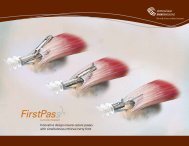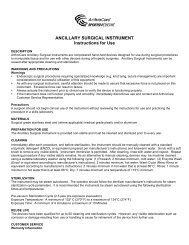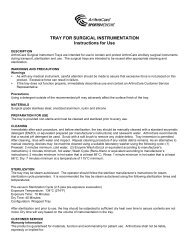Download the Technique Guide - ArthroCare Sports Medicine
Download the Technique Guide - ArthroCare Sports Medicine
Download the Technique Guide - ArthroCare Sports Medicine
You also want an ePaper? Increase the reach of your titles
YUMPU automatically turns print PDFs into web optimized ePapers that Google loves.
LabraLock ® P for Labrum Repair,<br />
Part of <strong>the</strong> OPUS ® LabraFix ® System<br />
A revolutionary system specifically designed<br />
for Bankart and SLAP repair surgery<br />
System Includes:<br />
• SpeedStitch ® Suturing Device<br />
• LabraLock P Implant<br />
The Drill and Fill <strong>Technique</strong> <strong>Guide</strong><br />
®
The System<br />
The LabraFix System from <strong>ArthroCare</strong>® <strong>Sports</strong> <strong>Medicine</strong>’s OPUS Collection is a groundbreaking<br />
new system specifically designed for Bankart and SLAP repair. The LabraFix<br />
System enables <strong>the</strong> surgeon to perform a secure knotless repair of <strong>the</strong> labrum through<br />
rapid suture and anchor placement combined with an unparalleled TensionLock<br />
mechanism in an arthroscopic or mini-open approach. The system consists of two<br />
innovative devices:<br />
The SpeedStitch Suturing Device<br />
The SpeedStitch suturing device has an integrated grasper and suturing design that allows <strong>the</strong> surgeon to<br />
stabilize <strong>the</strong> labrum and capsular tissue and arthroscopically place a stitch in <strong>the</strong> tissue in a matter of seconds.<br />
The unique design of <strong>the</strong> SpeedStitch allows for easy access to all parts of <strong>the</strong> labrum circumference, along with<br />
a deep bite into <strong>the</strong> labrum and capsular tissue, enabling a strong tissue hold coupled with capsular tightening.<br />
SpeedStitch Suturing Device<br />
Suturing Device Handle<br />
(OM-7000)<br />
The LabraLock P Implant<br />
The LabraLock P Implant is uniquely designed for use in <strong>the</strong> glenoid. The LabraLock P is a compact radiolucent<br />
PEEK anchor featuring interference bone fixation. The LabraLock P provides an efficient mechanism to transport<br />
<strong>the</strong> labrum tissue to <strong>the</strong> glenoid and secure <strong>the</strong> repair with a patented TriLock suture lock.<br />
LabraLock P Implant<br />
Deployment Knob<br />
Tissue Jaw Lever Ratchet Release<br />
Button<br />
Lock-Out Tab<br />
Ratchet Release Button<br />
Deployment Handle<br />
Needle Driver Lever<br />
Suture Ratchet Knobs<br />
Disposable<br />
Inserter Handle<br />
Barbed Sleeve<br />
Suture Cartridge<br />
(OM-808X)<br />
LabraLock P Implant<br />
Snare Wire Loop<br />
Suture Eyelet
SpeedStitch Suturing Device Preparation<br />
Loading <strong>the</strong> SpeedStitch Suturing<br />
Device Needle (OM-8850)<br />
The needle used by <strong>the</strong> SpeedStitch is provided in<br />
a sterile package and housed inside a needle loader.<br />
Step 1 Load <strong>the</strong> needle by squeezing <strong>the</strong> silver<br />
Tissue Jaw Lever of <strong>the</strong> SpeedStitch and<br />
inserting <strong>the</strong> cylindrical end of <strong>the</strong> loader<br />
over <strong>the</strong> telescoping jaw.<br />
Step 2 Push in <strong>the</strong> loader until its plastic tabs lock<br />
into <strong>the</strong> slots on <strong>the</strong> sides of <strong>the</strong> barrel of<br />
<strong>the</strong> SpeedStitch.<br />
Note:<br />
Never twist <strong>the</strong> needle loader or unloader. Only<br />
push or pull <strong>the</strong> loader axially along <strong>the</strong> barrel<br />
of <strong>the</strong> SpeedStitch.<br />
Step 3 Next, squeeze <strong>the</strong> gold Needle Driver Lever<br />
while holding <strong>the</strong> needle loader between<br />
thumb and forefinger. This maneuver will load<br />
<strong>the</strong> needle as well as eject <strong>the</strong> loader cartridge.<br />
Note:<br />
The gold Needle Driver Lever will not actuate<br />
unless <strong>the</strong> silver Tissue Jaw Lever is actuated.<br />
Step 4 Check that <strong>the</strong> SpeedStitch is ready to use<br />
by actuating both <strong>the</strong> silver Tissue Jaw Lever<br />
and <strong>the</strong> gold Needle Driver Lever.<br />
Loading <strong>the</strong> SpeedStitch Suture Cartridge<br />
Step 1 Load <strong>the</strong> Suture Cartridge by inserting<br />
its plastic tube end into <strong>the</strong> barrel of<br />
<strong>the</strong> SpeedStitch.<br />
Step 2 Continue feeding <strong>the</strong> plastic tube end into<br />
<strong>the</strong> barrel until <strong>the</strong> tabs on <strong>the</strong> metal end<br />
of <strong>the</strong> Suture Cartridge locks in place. Tug<br />
on <strong>the</strong> metal end to ensure firm coupling.<br />
The SpeedStitch suturing device is now ready to use.<br />
Step 1<br />
Step 2<br />
Step 3<br />
Step 4<br />
Step 1<br />
Step 2
Placing <strong>the</strong> Labrum Stitch<br />
Step 1a Close <strong>the</strong> jaw using <strong>the</strong> silver Tissue Jaw Lever<br />
and insert <strong>the</strong> closed SpeedStitch suturing<br />
device into <strong>the</strong> glenohumeral joint through an<br />
anterior portal using an 8.2mm diameter cannula<br />
or greater. (Closing <strong>the</strong> telescoping jaw using<br />
<strong>the</strong> silver handle ensures that <strong>the</strong> jaw does not<br />
inadvertently catch tissue during insertion.)<br />
Step 1b Insert <strong>the</strong> jaw of <strong>the</strong> suturing device into <strong>the</strong><br />
space between <strong>the</strong> glenoid bone and <strong>the</strong><br />
labrum tissue.<br />
Step 1c Then open <strong>the</strong> jaw and manipulate <strong>the</strong><br />
SpeedStitch to engage <strong>the</strong> labrum tissue<br />
into <strong>the</strong> jaw. This usually requires a simple<br />
90-degree rotation.<br />
Step 2a Next, stabilize <strong>the</strong> tissue by squeezing <strong>the</strong><br />
silver Tissue Jaw Lever of <strong>the</strong> SpeedStitch to<br />
advance <strong>the</strong> telescoping jaw.<br />
Step 2b Once <strong>the</strong> tissue is stabilized, squeeze <strong>the</strong> gold<br />
Needle Driver Lever fully, followed by a gentle<br />
release. The stitch is now placed.<br />
1b<br />
Surgical <strong>Technique</strong><br />
1a 1b<br />
Step 3 Release <strong>the</strong> tissue by pressing <strong>the</strong> Ratchet<br />
Release Button on <strong>the</strong> bottom of <strong>the</strong> silver<br />
Tissue Jaw Lever, <strong>the</strong>n close <strong>the</strong> jaw again and<br />
withdraw <strong>the</strong> SpeedStitch from <strong>the</strong> shoulder.<br />
Step 4 To remove <strong>the</strong> suture from <strong>the</strong> suture hook,<br />
first partially open <strong>the</strong> silver Tissue Jaw<br />
Lever. Next, squeeze <strong>the</strong> gold Needle Driver<br />
Lever to expose <strong>the</strong> suture hook and pull <strong>the</strong><br />
suture down and towards <strong>the</strong> handle. Clear<br />
<strong>the</strong> suture hook of any particles before placing<br />
ano<strong>the</strong>r stitch.<br />
<strong>Technique</strong> Tip: portal placement<br />
It is very important to have a good “angle of attack”<br />
for accessing <strong>the</strong> labrum, drilling holes into <strong>the</strong> glenoid,<br />
and placing <strong>the</strong> LabraLock P. It is advisable to use a<br />
guidewire with <strong>the</strong> Atlantech ® Caps-Lock ® cannula or<br />
a spinal needle to identify appropriate portal location.<br />
1a 1b<br />
1c<br />
1c<br />
Step 1a<br />
Step 1b Step 1c<br />
Step 2a<br />
1a 1b<br />
2a<br />
2a 2b<br />
Step 2b<br />
<strong>Technique</strong> Tip: labrum preparation<br />
An <strong>ArthroCare</strong> CoVator ® ArthroWand ® is specifically<br />
designed to elevate <strong>the</strong> labral tissue from <strong>the</strong> glenoid.<br />
1c<br />
2b<br />
1c
Preparing <strong>the</strong> Drill Holes for <strong>the</strong> LabraLock P Implant:<br />
The drill hole sites are planned by applying traction on <strong>the</strong> suture limbs. It is very important to drill <strong>the</strong> hole 2mm<br />
from <strong>the</strong> glenoid rim onto <strong>the</strong> articular surface of <strong>the</strong> glenoid. This helps create an anatomic “bumper” with <strong>the</strong><br />
labrum. For superior implant sites, it is acceptable to drill on <strong>the</strong> glenoid rim.<br />
Step 1 Through <strong>the</strong> same cannula, insert <strong>the</strong> LabraFix drill<br />
guide with <strong>the</strong> sharp-ended obturator. Place <strong>the</strong> tip<br />
of <strong>the</strong> drill guide at <strong>the</strong> desired site of <strong>the</strong> drill hole.<br />
Tap <strong>the</strong> proximal end of <strong>the</strong> obturator lightly to<br />
create a “starter hole”.<br />
Note:<br />
Drilling perpendicular is NOT required with<br />
<strong>the</strong> LabraLock P. However, drilling at too<br />
shallow of an angle will result in <strong>the</strong> drill<br />
“walking” or a superficially placed implant.<br />
LabraLock P<br />
Step 2 Next, withdraw <strong>the</strong> obturator and insert <strong>the</strong><br />
fluted 2.6mm LabraLock P drill (blue). Drill until<br />
<strong>the</strong> depth-stop at <strong>the</strong> proximal end of <strong>the</strong> drill is<br />
against <strong>the</strong> proximal end of <strong>the</strong> drill guide. This<br />
depth corresponds to a laser etched depth marker<br />
on <strong>the</strong> drill, visible in <strong>the</strong> arthroscopic view.<br />
Note:<br />
While creating <strong>the</strong> hole, <strong>the</strong> drill should be angled<br />
into <strong>the</strong> scapular neck, to avoid drilling across <strong>the</strong><br />
lip of <strong>the</strong> glenoid.<br />
Note:<br />
While drilling <strong>the</strong> hole, it is important to hold <strong>the</strong><br />
sutures taut to avoid tangling of <strong>the</strong> sutures on<br />
<strong>the</strong> drill. Alternatively, drill holes may be created<br />
before <strong>the</strong> suture is placed.<br />
Step 3 Once <strong>the</strong> hole is made, remove <strong>the</strong> drill and<br />
insert <strong>the</strong> LabraLock P PathFinder ® (blue) into<br />
<strong>the</strong> hole to maintain alignment while <strong>the</strong><br />
LabraLock P is prepared for insertion.<br />
<strong>Technique</strong> Tip: drill angle<br />
Drill should be angled into <strong>the</strong> scapular neck,<br />
however a perpendicular angle is not required.
Deploying <strong>the</strong> LabraLock P Implant<br />
Step 1 Pass both ends of <strong>the</strong> suture through<br />
<strong>the</strong> Snare Wire Loop and adjust so that<br />
approximately 2 inches (5cm) of both<br />
suture ends extend from <strong>the</strong> distal end<br />
of <strong>the</strong> wire loop.<br />
Step 2 Take up <strong>the</strong> suture slack by rotating <strong>the</strong><br />
Suture Ratchet Knobs with both hands in <strong>the</strong><br />
direction of <strong>the</strong> arrows until suture is visible<br />
on <strong>the</strong> suture reel.<br />
Step 3 When preparing to insert <strong>the</strong> implant into<br />
<strong>the</strong> portal, remove <strong>the</strong> black Suture Loader by<br />
pulling <strong>the</strong> tab in <strong>the</strong> direction of <strong>the</strong> arrow.<br />
Step 4 Advance <strong>the</strong> implant down <strong>the</strong> portal until <strong>the</strong><br />
implant is just outside <strong>the</strong> drilled hole in <strong>the</strong><br />
glenoid. Take up suture slack by turning <strong>the</strong><br />
Suture Ratchet Knobs in <strong>the</strong> direction of <strong>the</strong><br />
arrow on <strong>the</strong> body of <strong>the</strong> Inserter Handle until<br />
approximately 15mm of suture can be clearly<br />
seen between <strong>the</strong> labrum and <strong>the</strong> implant.<br />
Important:<br />
• Ensure that <strong>the</strong> implant is oriented so<br />
that <strong>the</strong> suture emerges directly from <strong>the</strong><br />
Suture Eyelet straight towards <strong>the</strong> stitch in<br />
<strong>the</strong> labrum.<br />
• Check that <strong>the</strong> entire length of <strong>the</strong> suture<br />
is visible from <strong>the</strong> labrum to <strong>the</strong> implant to<br />
ensure <strong>the</strong>re are no tissue bridges.<br />
• About 15mm or more should be left so that<br />
<strong>the</strong> labrum is not overtightend and <strong>the</strong><br />
eyelet does not bend while tensioning.<br />
• Do not split <strong>the</strong> sutures with <strong>the</strong> implant.<br />
Step 1<br />
Step 2<br />
Step 3<br />
Step 4<br />
2"<br />
2"
Step 5a Rotate <strong>the</strong> Lock-Out Tab at <strong>the</strong> proximal end of<br />
<strong>the</strong> Deployment Handle a 1/4 turn so that <strong>the</strong><br />
Lock-Out Tab is aligned with <strong>the</strong> slot in <strong>the</strong> handle.<br />
Step 5b Depress Deployment knob completely with thumb<br />
to advance Barbed Sleeve completely over <strong>the</strong><br />
implant.<br />
Step 6 Maintaining a light grip on <strong>the</strong> Inserter Handle,<br />
tap <strong>the</strong> end of <strong>the</strong> Deployment Handle with a<br />
mallet to drive <strong>the</strong> implant into <strong>the</strong> bone hole<br />
until at least <strong>the</strong> first horizontal laser mark on <strong>the</strong><br />
implant insertion shaft is at <strong>the</strong> articular surface<br />
of <strong>the</strong> glenoid. Continue tapping until <strong>the</strong> desired<br />
tension is achieved.<br />
Note:<br />
Each horizontal laser mark is 1mm apart.<br />
Step 7 Detach <strong>the</strong> inserter handle by turning <strong>the</strong><br />
deployment handle 180 degrees clockwise in <strong>the</strong><br />
direction of <strong>the</strong> arrow. Remove <strong>the</strong> handle.<br />
Step 8 Trim <strong>the</strong> sutures using <strong>the</strong> arthroscopic<br />
MagnumWire® suture cutter.<br />
The above sequence is repeated to place <strong>the</strong> desired<br />
number of implants to complete <strong>the</strong> labrum repair.<br />
<strong>Technique</strong> Tip:<br />
If a slight increase in tension is desired once <strong>the</strong> inserter<br />
5<br />
handle is removed, reinsert <strong>the</strong> inserter handle into <strong>the</strong><br />
appropriate hole until it is seated properly with <strong>the</strong> implant.<br />
Then, lightly tap <strong>the</strong> inserter handle until <strong>the</strong> desired tension<br />
is achieved. Do not use any o<strong>the</strong>r device to drive <strong>the</strong> implant<br />
down fur<strong>the</strong>r as it may damage <strong>the</strong> implant.<br />
180<br />
1 2<br />
3<br />
180<br />
180<br />
4<br />
6<br />
Step 6<br />
Step 7<br />
180<br />
180<br />
180<br />
180<br />
3<br />
Step 5a Step 5b<br />
5<br />
180<br />
Step 8<br />
4<br />
6<br />
180<br />
180
To order or for more information, please contact your <strong>ArthroCare</strong> <strong>Sports</strong> <strong>Medicine</strong><br />
representative or customer service at 800-797-6520.<br />
Visit our website at www.arthrocaresportsmedicine.com.<br />
<strong>ArthroCare</strong> <strong>Sports</strong> <strong>Medicine</strong><br />
680 Vaqueros Avenue<br />
Sunnyvale, CA 94085-3523<br />
main phone 408-736-0224<br />
order entry 800-797-6520<br />
order entry fax 888-994-2782<br />
arthrocaresportsmedicine.com<br />
<strong>ArthroCare</strong> Europe AB<br />
Baggensgatan 25<br />
111 31 Stockholm<br />
Sweden<br />
phone +46 8 546 172 00<br />
fax +46 8 546 172 39<br />
info@arthrocare.se<br />
CAUTION: Federal (USA) law restricts this device to sale by or on <strong>the</strong> order of a physician.<br />
© 2009 <strong>ArthroCare</strong> Corporation. All rights reserved. All trademarks, service marks, and logos listed herein are registered<br />
and unregistered trademarks of <strong>ArthroCare</strong> Corporation, its affiliates, subsidiaries, or a third party who has licensed its<br />
trademarks to <strong>ArthroCare</strong>.<br />
P/N A1085 Rev A







